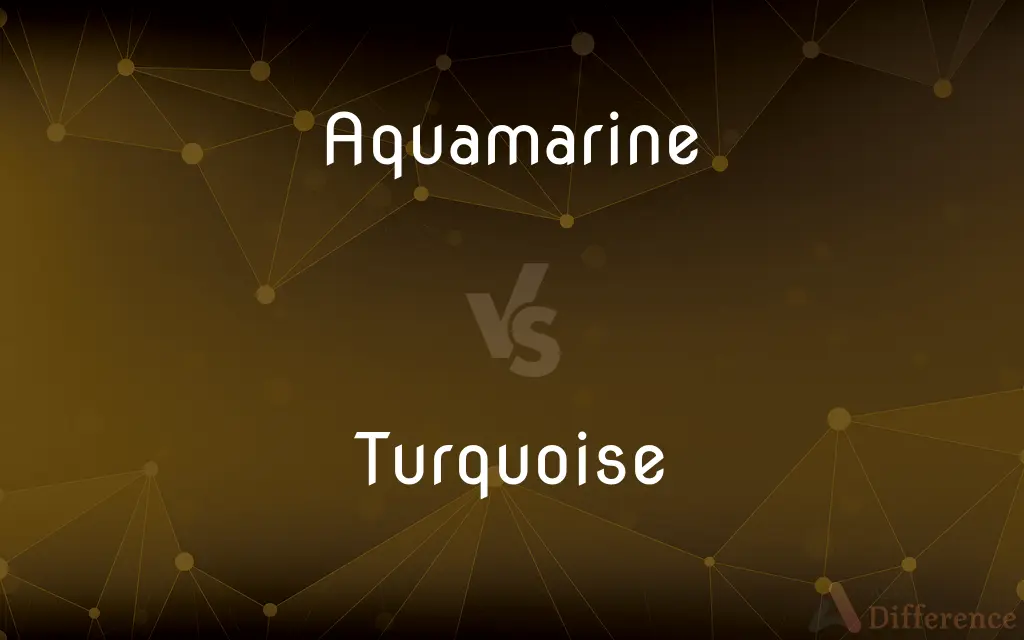Aquamarine vs. Turquoise — What's the Difference?
By Fiza Rafique & Urooj Arif — Updated on April 29, 2024
Aquamarine and turquoise are both gemstones with distinctive blue hues, but aquamarine has a clear, sea-blue color and is part of the beryl family, whereas turquoise is opaquer, typically blue-green, and composed of phosphate.

Difference Between Aquamarine and Turquoise
Table of Contents
ADVERTISEMENT
Key Differences
Aquamarine is known for its clarity and range of blue tones, from light to deep blue, often resembling the clear blue of the ocean. It is a variety of beryl, making it a relative of emerald and is prized in jewelry for its transparency and hardness. On the other hand, turquoise is easily identifiable by its blue-green color and is more opaque with a waxy to matte luster. It often contains veins or patches of other materials, known as matrix, which can be black, brown, or yellowish-brown.
While aquamarine is typically faceted to enhance its light-reflecting properties and clarity, turquoise is usually cut en cabochon or formed into beads, which highlights its unique color and matrix patterns. The faceting of aquamarine allows for brilliant sparkle, ideal for fine jewelry, whereas the smooth, rounded surfaces of cabochon turquoise emphasize its rich, even color and intrinsic patterns.
Aquamarine is generally found in granite rocks and is associated with mica schists, while turquoise forms as a secondary mineral in copper deposits, often in arid regions. The geological conditions for forming aquamarine involve high temperatures and pressures, which is why it's often mined in mountainous areas, particularly in countries like Brazil and Pakistan. Conversely, turquoise deposits are typically found in places such as Iran, the southwestern United States, and Sinai.
In terms of symbolism and use, aquamarine is often associated with calmness, clarity, and protection for sailors, reflecting its water-like colors. Turquoise has been valued for thousands of years for its supposed protective properties and use as a talisman, common in both ancient and modern cultures, particularly Native American and Persian.
Despite both stones being used in jewelry, the care for each differs significantly due to their hardness. Aquamarine, being a harder gemstone, is more resistant to scratching and everyday wear, whereas turquoise is softer and more porous, requiring careful handling to avoid damage from oils, cosmetics, and other chemicals.
ADVERTISEMENT
Comparison Chart
Color
Light blue to deep ocean blue
Typically blue-green with possible veins
Composition
Beryl (beryllium aluminum silicate)
Phosphate mineral
Hardness
7.5-8 on the Mohs scale
5-6 on the Mohs scale
Transparency
Transparent to translucent
Opaque
Typical Cut
Faceted
Cabochon
Symbolism
Serenity, clarity, protection
Protection, healing, good fortune
Common Sources
Brazil, Pakistan
Iran, USA, Sinai
Compare with Definitions
Aquamarine
Sourced mainly from mountainous regions.
The finest aquamarine is sourced from deep within the mountains of Brazil.
Turquoise
An opaque, blue-green mineral that is a hydrated phosphate of copper and aluminum.
The artisan's turquoise bracelet was accented with silver, highlighting its earthy tones.
Aquamarine
Associated with water, symbolizing calm and clarity.
Aquamarine is considered a calming gemstone, often used in meditation practices.
Turquoise
Often contains matrix, adding a unique pattern to each piece.
The turquoise used in the necklace featured a striking matrix that made it one-of-a-kind.
Aquamarine
Valued for its clarity and sparkling ocean-like colors.
Her aquamarine earrings glittered brilliantly under the gala's lights.
Turquoise
Popular in Southwestern and Native American jewelry.
Turquoise is a staple in Southwestern jewelry, celebrated for its natural beauty and cultural significance.
Aquamarine
A pale blue to greenish-blue variety of beryl.
The jeweler showcased a stunning aquamarine necklace set in white gold.
Turquoise
Requires careful handling to maintain its color and finish.
She stored her turquoise necklace away from sunlight to prevent color fading.
Aquamarine
Often used in high-quality jewelry due to its hardness.
Aquamarine rings are popular for their durability and beauty.
Turquoise
Believed to offer protection and healing properties.
Turquoise amulets are thought to protect the wearer from negative energy.
Aquamarine
A transparent blue-green variety of beryl, used as a gemstone.
Turquoise
Turquoise is an opaque, blue-to-green mineral that is a hydrated phosphate of copper and aluminium, with the chemical formula CuAl6(PO4)4(OH)8·4H2O. It is rare and valuable in finer grades and has been prized as a gemstone and ornamental stone for thousands of years owing to its unique hue. Like most other opaque gems, turquoise has been devalued by the introduction onto the market of treatments, imitations and synthetics.
Aquamarine
A pale blue to light greenish blue.
Turquoise
A greenish-blue colour
The turquoise waters of the bay
Aquamarine
The bluish-green colour of the sea.
Turquoise
A semi-precious stone, typically opaque and of a greenish-blue or sky-blue colour, consisting of a hydrated phosphate of copper and aluminium.
Aquamarine
A bluish-green variety of beryl.
Turquoise
A blue to blue-green mineral of aluminum and copper, mainly CuAl6(PO4)4(OH)8·4H2O, prized as a gemstone in its polished blue form.
Aquamarine
Of a bluish-green colour.
Turquoise
A light to brilliant bluish green.
Aquamarine
A transparent, pale green variety of beryl, used as a gem. See Beryl.
Turquoise
(countable) A sky-blue, greenish-blue, or greenish-gray semi-precious gemstone.
Aquamarine
A transparent variety of beryl that is blue green in color
Turquoise
A pale greenish-blue colour, like that of the gemstone.
Aquamarine
A shade of blue tinged with green
Turquoise
Made of turquoise (the gemstone).
Turquoise
Having a pale greenish-blue colour.
Turquoise
A hydrous phosphate of alumina containing a little copper; calaite. It has a blue, or bluish green, color, and usually occurs in reniform masses with a botryoidal surface.
Turquoise
Having a fine light blue color, like that of choice mineral turquoise.
Turquoise
A blue to gray green mineral consisting of copper aluminum phosphate; blue turquoise is valued as a gemstone
Turquoise
A shade of blue tinged with green
Common Curiosities
Why is turquoise often found with veins?
The veins, or matrix, are remnants of the rock in which turquoise formed and are composed of other minerals.
What is the main difference between aquamarine and turquoise?
Aquamarine is transparent with a blue hue and is part of the beryl family, while turquoise is opaque, typically blue-green, and composed of phosphate.
Which gemstone is harder, aquamarine or turquoise?
Aquamarine is harder, scoring 7.5-8 on the Mohs scale, compared to turquoise's 5-6.
Can aquamarine and turquoise be used interchangeably in jewelry?
While both can be used in jewelry, they serve different aesthetic and functional purposes due to differences in color, hardness, and typical cuts.
Are aquamarine and turquoise both birthstones?
Yes, aquamarine is the birthstone for March, and turquoise is one of the birthstones for December.
What are the best care practices for turquoise jewelry?
Turquoise should be kept away from oils, perfumes, and chemicals and stored out of direct sunlight to prevent damage and color change.
Which gemstone typically commands a higher price?
Typically, high-quality aquamarine can command higher prices due to its clarity and use in fine jewelry.
What makes aquamarine and turquoise popular in different cultures?
Aquamarine's association with water and clarity makes it popular in many cultures, while turquoise's protective qualities have made it significant in Native American and Middle Eastern cultures.
How do the symbolic meanings of aquamarine and turquoise differ?
Aquamarine symbolizes serenity and clarity, while turquoise is associated with protection and healing.
How do aquamarine and turquoise form in nature?
Aquamarine forms in pegmatites and certain metamorphic rocks, while turquoise develops in arid regions as a secondary mineral in copper deposits.
Share Your Discovery

Previous Comparison
Organised vs. Organized
Next Comparison
Simplistic vs. SimpleAuthor Spotlight
Written by
Fiza RafiqueFiza Rafique is a skilled content writer at AskDifference.com, where she meticulously refines and enhances written pieces. Drawing from her vast editorial expertise, Fiza ensures clarity, accuracy, and precision in every article. Passionate about language, she continually seeks to elevate the quality of content for readers worldwide.
Co-written by
Urooj ArifUrooj is a skilled content writer at Ask Difference, known for her exceptional ability to simplify complex topics into engaging and informative content. With a passion for research and a flair for clear, concise writing, she consistently delivers articles that resonate with our diverse audience.












































